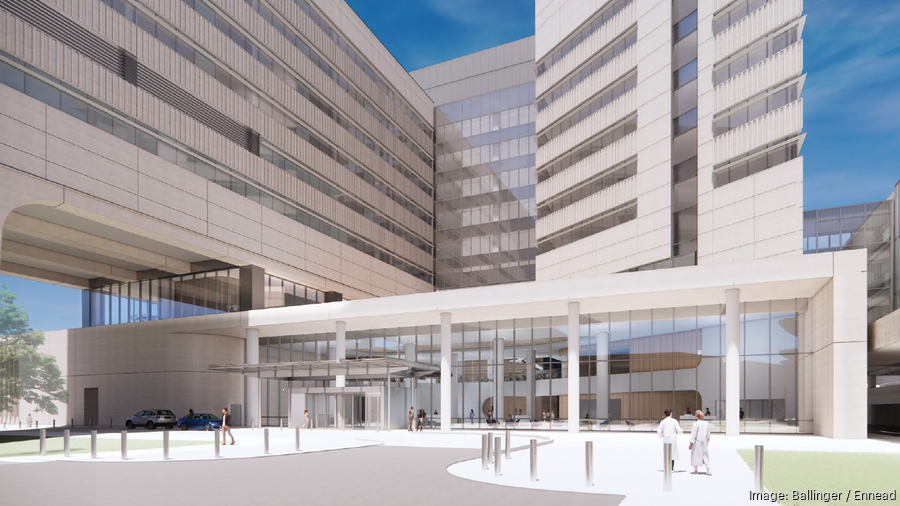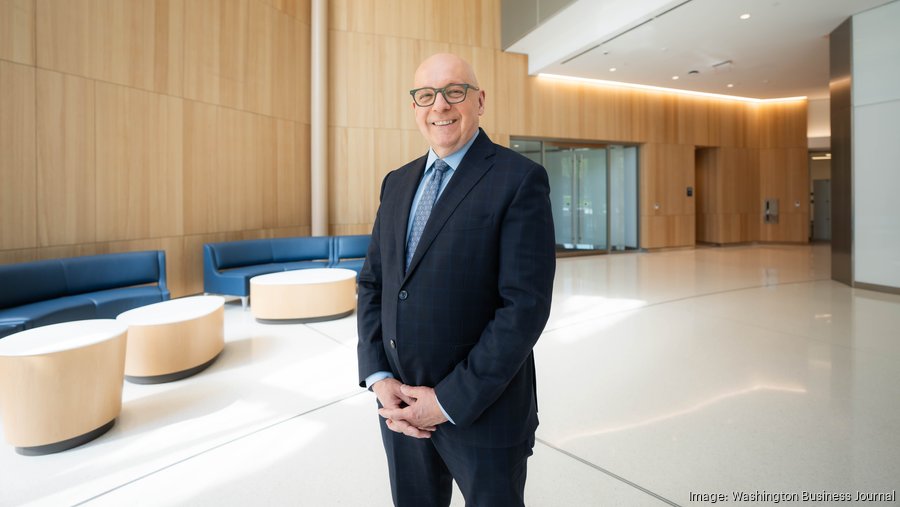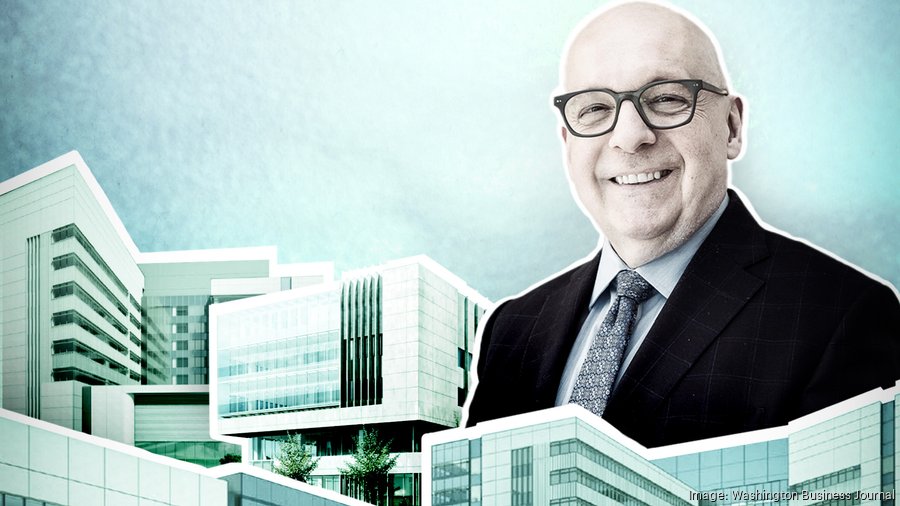Listen to this article 3 min
"If you take this job, you’re going to have to replace that hospital.”
That suggestion was one of the first things Dr. Stephen Jones heard about Inova Health System’s Alexandria hospital when interviewing for the nonprofit’s top slot more than six years ago.
The cancer surgeon and longtime Cleveland Clinic executive didn’t think much of it — he’d worked in plenty of old buildings — and certainly didn’t expect to be spearheading an ambitious effort to replace the aging acute-care facility through a global health crisis.
But soon after becoming the Falls Church nonprofit’s CEO in April 2018, he found that “it really did have to be replaced,” he told me in an interview, sketching the building’s wonky shape and surrounding roads on a piece of paper. There was no good way to expand it, and there was no site large enough within the city of Alexandria to put a new one of the scale Inova envisioned.
The solution was to build not one, but two state-of-the-art facilities five miles apart, one in Alexandria and another in the Franconia-Springfield area, each spanning roughly 1 million square feet, as well as an outpatient medical complex nearby. Inova’s board approved the concept in December 2019, as the Covid-19 pandemic loomed.
At the same time, Inova was deep into an ambulatory expansion and changes to its operating structure. The system includes five hospitals and outpatient sites, urgent care centers and physician practices.
The expansion effort has become a massive, unprecedented undertaking that, when finished, would give the 1,840-bed, $5.7 billion health system crucial additional space to meet growing demand from a growing patient population. It would fill holes in the health care landscape and reduce a burden on Inova’s existing hospitals. And it would broaden the system’s footprint within Northern Virginia as competitors, who have opposed the project, fight for market share.
To pull this off, Inova must secure a colossal $2.5 billion from multiple funding sources, recruit and reshuffle workers amid an ongoing labor crisis, decommission an old building, and transition services and operations to the new ones, all without disrupting care. It must thread the needle between the sky-high interest rates and the significant investment — and debt — needed to build and hire in this landscape, the same factors that have delayed and derailed multiple Greater Washington projects.
For Inova, it’s a long game — a wager on its own future.
“We have a responsibility to do this: We have a responsibility to assure that our community has the right health care,” Jones said. “So if it’s hard, and it’s expensive, then that’s on us to figure out — but we do have that responsibility, outside of the business ramifications.”
Financial health
In 2020, health systems across the country, including Inova, were up against what Jones called at the time “the most significant financial challenge of any of our histories.”
That’s when he announced Inova’s plans to build two new full-service hospitals and nearby health complex. The system couldn’t risk waiting longer, given the intense planning and time it would take to get all of that done. Four years later, it’s not even halfway to its expected finish line. The price tag, originally pegged at about $2 billion all in, has already swelled.
“We had to go back to the board within the past year and say, ‘We’ve seen inflation significantly change that,’” Jones said. “It’s probably going to be about $2.5 billion in total spend for us to do all of that work.”
That work includes the Alexandria medical campus on the former Landmark Mall property, originally pegged at roughly $1 billion, which calls for a hospital building, cancer center and specialty care center on roughly 10 acres. Then there’s the Springfield hospital, initially expected to cost $612 million, which would comprise a six-story acute-care building and outpatient center near an existing Inova complex it calls a HealthPlex.
Both sites, nearing construction this year with targeted 2028 deliveries, would follow the opening this fall of the Oakville Triangle HealthPlex with an emergency department, outpatient care center and medical offices.
The costs of each have ballooned since those early projections. Inova declined to disclose the expected breakdown between the sites, but said it intends to fund this work through bond proceeds, funds generated from earnings and philanthropic dollars. Its team is still in the process of determining exact amounts from each funding bucket.
What doesn’t help: Nonprofit health systems have inherently thin margins. Operations will pay for part of the final bill, and it won’t all hit in the first year.
“These buildings are here for 40 years,” Jones said. “Over that 40-year period, ultimately, you have to have made enough to have paid for the building, or you can’t turn the lights on.”
Inova does not expect to receive any direct government funding. Philanthropy, though, is critical — and hinges on donors believing in its care, perhaps best exemplified by Dwight and Martha Schar’s $75 million gift last year that Inova’s foundation is close to matching through other donations. Once that’s done, Jones said, Inova will establish its next goal to help finance the new hospitals.
The system, which reported $2.1 billion in total long-term outstanding debt at the end of December, will determine how much debt to issue depending on what’s happening in the capital markets, Jones said. What’s not an option, he said, is to allow Inova’s strong financial rating to take a hit (it earned an AA+ rating from S&P last year); maintaining a high rating is critical for continued access to capital. That’s also not a concern, he added, because Inova’s continual modeling — as costs associated with construction and labor have climbed — has reaffirmed its ability to take on a project of this magnitude.
“Now, we’re not cavalier about it. It is complex. You don’t spend $2.5 billion and be cavalier and keep your job very long,” Jones said. “But we are very comfortable that we have done the right planning to be ready for that.”







Inova Alexandria: The main entry to the hospital.
‘Not over yet’
More expenses will follow, including for labor, though specific costs are unknown at this time. The bulk of staffing at the new facilities will come from the current Alexandria hospital, which has about 1,600 employees. Inova expects to hire nearly 240 people — 144 full-time positions at the Landmark site and 94 at Springfield.
While the project will not create a thousand new jobs the day the doors open, recruitment is still a key piece of Inova’s expansion. So far this year, it’s been averaging about 100 new hires per week, now with 24,391 employees across the organization — 5,200 more people, or a 27% increase, from its headcount at the end of 2020. Its turnover rate is down to roughly 12%, from as high as 50% during the peak of the Covid crisis, Jones said, attributing the drop to earlier changes to compensation and benefits, as well as a focus on recruitment, retention and culture.
Inova isn’t just competing for talent, but to preserve its foothold as one of the region’s largest employers and Northern Virginia’s dominant health care provider — with the most locations and largest headcount. Arlington’s VHC Health, the nonprofit behind Northern Virginia’s only independent hospital, tried to block Inova’s proposed Springfield facility in fall 2022. VHC, also in expansion mode, said such a hospital would threaten its own business, because their service areas would overlap.
Inova has argued Springfield represents an important and growing area from which residents flock to the system’s congested Fairfax medical center. The new facility stands to alleviate pressure on that Fairfax campus, shifting routine services closer to patients and preserving the flagship hospital for the most complex treatments and procedures. Inova has since earned the Virginia Department of Health’s green light to move forward with its plans despite that pushback.
Supporters see Inova’s expansion as a draw for new companies and a catalyst for jobs, housing, development and greater benefit over time — much like Johns Hopkins Hospital in Baltimore, said Victor Hoskins, president and CEO of the Fairfax County Economic Development Authority. “You always take risk when you’re pursuing an opportunity; it is a massive opportunity,” he said. “It starts out with the hospital, but over time, you help build the community, and that’s what’s really, I think, the opportunity we all see.”
The Springfield site’s proximity to the Franconia-Springfield Metro station and access to the Virginia Railway Express also matter for the talent the new hospital would attract, Hoskins added. “Those are really irreplaceable infrastructure opportunities, and that’s what this location will capitalize on.”
Inova still has to nail down when each building will open relative to the other, and how to best shutter the existing Alexandria hospital, Jones said. The new hospitals wouldn’t open for about six months after Inova gets the keys, so everyone knows “exactly where the Band-Aids are,” he said. And the overall timeline could also change, as is the case with any such large project.
Its ambulatory expansion, which will involve standing up new clinics, will also continue in the areas from which “people currently have to get in a car and go a long way to get that care,” Jones said. He said he has “a couple of thoughts” as to where those will be, but declined to disclose them.
It will all help push Inova farther down the path that Jones charted when he took over Inova, scrapping plans his predecessor had laid out and reorganizing the care model to create a more cohesive system. His goal, he maintains, is to improve health care for D.C.-area residents decades down the road, as much as to ensure the nonprofit is around to deliver it.
“If I look at what we’ve accomplished, it’ll be that we assured that patients didn’t need to leave this community for their care — and that means all our patients, not just our affluent patients,” Jones said. “And if we’ve got the facilities to do it, that’s gravy. But the facilities are just tools.”
“It’s been quite a journey,” he said, “but it’s not over yet.”

Dr. Stephen Jones: Why Inova is spending the money to expand
What were the changes you set out to make when you became Inova’s CEO in 2018? Health care historically is pretty siloed. What I saw was the opportunity here, in an environment where we had care already that I think was second-to-none. What it wasn’t was one system. As opposed to hospitals competing against each other, as opposed to physicians and hospitals being in the same ecosystem but not necessarily working together, I saw if we could pull all that together, we can actually serve our patients better.
What impact do you hope to see from those changes? What I want is that, regardless of who you are, whether you’re in an affluent area here in our community, or in the most disadvantaged area in our community, is that you will have access to that same level of quality care, and the same experience. We’re still on a journey, of course, because we also want to be responsible. We’re not going in and retrofitting every clinic that we’ve got with the same carpet. But over time, you try to develop that consistency, so people know they’re in a place that they trust. We’re in the trust business.
What’s your take on the competition in Northern Virginia’s health care market? We welcome competition, and we want healthy competition, because if we don’t have competition, we’ll get lazy ourselves. At the end of the day, in this community — in most communities in America, but certainly this community — there are more people who need care than, really, we have capacity for.
What misconceptions have you encountered about funding a project of this scale? People have said, “Why does the health system need to have a strong balance sheet?” It’s so you can take care of your community. In fact, I have, for a long time, said, “There’s nothing aspirational in a not-for-profit health system about money, except what you can do with it.” It doesn’t go to equity holders, it doesn’t go to stock options, so it’s what you can do with your resources. And here, we can indeed replace Inova Alexandria with two different sites, we can build new locations in all of the places we talked about. We can add technology, we can bring in top talent, and that all indeed takes those resources.
In addition to the time you knew the project would require, why did you announce it in 2020, during the Covid-19 pandemic’s height? I wanted our community to understand, I wanted our team members to understand, that even though right now we are fighting Covid, and we’re in one of the most challenging times of our careers, there’s hope. We’re going to have a future here. We’re going to keep our eye on the horizon. And as hard as things are right now, we’ve got a bright future here — and let’s not get distracted from that.


